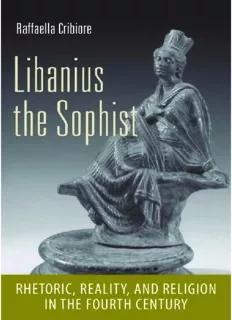
Libanius the Sophist: Rhetoric, Reality, and Religion in the Fourth Century PDF
Preview Libanius the Sophist: Rhetoric, Reality, and Religion in the Fourth Century
c LIBANIUS THE SOPHIST a volume in the series TOWNSEND LECTURES/CORNELL STUDIES IN CLASSICAL PHILOLOGY Edited by Frederick M. Ahl, Theodore R. Brennan, Charles F. Brittain, Gail J. Fine, Michael Fontaine, Kim Haines-E itzen, David P. Mankin, Sturt W. Manning, Alan J. Nussbaum, Hayden N. Pelliccia, Verity Platt, Pietro Pucci, Hunter R. Rawlings III, Éric Rebillard, Jeffrey S. Rusten, Barry S. Strauss, Michael Weiss A list of titles in this series is available at w ww .cornellpress .cornell .edu . LIBANIUS f THE SOPHIST f RHETORIC, REALITY, AND RELIGION IN THE FOURTH CENTURY Raffaella Cribiore CORNELL UNIVERSITY PRESS Ithaca and London Copyright © 2013 by Cornell University All rights reserved. Except for brief quotations in a review, this book, or parts thereof, must not be reproduced in any form without permission in writing from the publisher. For information, address Cornell University Press, Sage H ouse, 512 East State Street, Ithaca, New York 14850. First published 2013 by Cornell University Press Printed in the United States of America Library of Congress Cataloging-i n- Publication Data Cribiore, Raffaella, author. Libanius the sophist : rhetoric, reality, and religion in the fourth century / Raffaella Cribiore. pages cm. — (Townsend lectures/Cornell studies in classical philology) Includes bibliographical references and index. ISBN 978- 0- 8014- 5207- 9 (cloth : alk. paper) 1. Libanius— Criticism and interpretation. I. Title. PA4228C75 2013 885'.01—dc23 2013006266 Cornell University Press strives to use environmentally responsible suppliers and materials to the fullest extent possible in the publishing of its books. Such materials include vegetable-b ased, low- VOC inks and acid- free papers that are recycled, totally chlorine-f ree, or partly composed of nonwood fi bers. For further information, visit our website at w ww .cornellpress .cornell .edu . Cloth printing 10 9 8 7 6 5 4 3 2 1 To the two Stefania, most important in my life v Tychē of Antioch, Roman, 2nd Century AD, bronze overlaid with gold. Courtesy Worcester Art Mu- seum, Worcester, Massachusetts, Stoddard Acquisition Fund. c Contents Preface and Ac know ledg ments ix Introduction 1 1. Rhetoric and the Distortion of Reality 25 2. A Rhetor and His Audience: The Role of Invective 76 3. A Man and His Gods 132 4. God and the Gods 182 Conclusion: Julian’s School Edict Again 229 Selected Bibliography 239 Index 257 c Preface and Ac know ledg ments When A. F. Norman was asked why he had decided to make the study of the works of Libanius a large part of his life’s work, he replied that they occupied a very large portion of a shelf in the library; so much of this writer was preserved that he was intrigued and de- cided to devote full attention to him. One of the strands that run through this book is indeed the question of why Libanius was and remained so pop- u lar in antiquity and afterward but lost much of his appeal in the modern age. Besides the quantity of his extant production, its quality and variety compel one to look at the many faces of a sophist who was a professor of rhetoric, a composer of orations, a public fi gure, and a man at the center of a complex epistolary network. Libanius has been my daily companion for several years. In the book I wrote in 2007, The School of Libanius in Late Antique Antioch, I was primarily attracted by Libanius the teacher and by the eminence of his school, which aimed to rival rhetoric in Athens. Because of my previous interest in educa- tion in antiquity, Libanius and his students offered natural and challenging areas of inquiry. But there is so much of Libanius that still waits to be ex- plored, so many aspects of his personality and activities that can be of use in gaining a better understanding of the world of the fourth century, that I could not let this call go unanswered. Translating and studying Libanius has become ever more rewarding because it is now clear that he was not dis- engaged from reality but was immersed in the life of his society, fi ghting cor- ruption and brutality and communicating with pagans and Christians alike. The offer to deliver the Townsend Lectures in the fall of 2010 gave me the occasion to study new material. When Hayden Pelliccia told me that the lectures had to be entirely new, I felt duly impressed and intimidated and immediately got down to work. The time I spent at Cornell University was blissful, and for that I thank, besides Hayden, Charles Brittain, Pietro and Janine Pucci, Kim Haines- Eitzen, and the rest of a friendly and stimulat- ing faculty. I am grateful to Éric Rebillard (who was then on leave abroad) for coming to one of the lectures, reading the rest of them, and offering ix
Description: